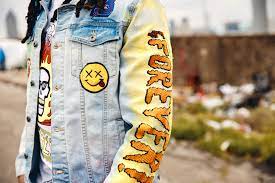The Evolution of “Born Fly”: How Streetwear Became Mainstream

Step into the world of streetwear, where fashion meets attitude and self-expression takes center stage. Born Fly, a brand that has become synonymous with this urban culture, has undergone an incredible evolution over the years. From its humble beginnings on the streets to becoming a mainstream sensation, Born Fly embodies the spirit of youth rebellion and individuality.
In this blog post, we will delve into the fascinating journey of how streetwear went from being an underground movement to a global phenomenon. We will explore the influence of hip-hop culture, game-changing collaborations with high-end brands, and how mainstream success propelled streetwear into the fashion stratosphere. Get ready to witness firsthand how Born Fly soared above all expectations and left an indelible mark on both style enthusiasts and industry insiders alike.
Join us as we unravel the captivating story behind “Born Fly”: How Streetwear Became Mainstream.
The Rise of
In the not-so-distant past, streetwear was confined to the urban corners and underground scenes. It was a form of rebellion against mainstream fashion norms, with its roots deeply intertwined with hip-hop culture. But as the years rolled by, something extraordinary happened – streetwear started gaining momentum and captivating a wider audience.
This rise can be attributed to several factors that contributed to its growing popularity. Social media platforms like Instagram became powerful tools for showcasing personal style and spreading trends like wildfire. Streetwear enthusiasts were able to connect with each other across borders, forming a global community united by their love for this unique fashion movement.
Additionally, celebrities and influential figures began embracing streetwear as their go-to look. From musicians rocking oversized hoodies on stage to athletes sporting logo-emblazoned sneakers off the court, these icons played a pivotal role in propelling streetwear into the mainstream consciousness.
Furthermore, brands such as Born Fly emerged during this time period – offering fresh designs that resonated with young individuals seeking self-expression through clothing. These brands infused elements from skateboarding culture, graffiti artistry, and music influences into their garments – creating an authentic aesthetic that spoke directly to those who craved originality.
As demand for streetwear increased exponentially over time, high-end fashion labels took notice of its allure and sought collaborations with prominent designers in the streetwear realm. This fusion of luxury meets urban sensibility elevated the status of street-inspired clothing even further – effectively blurring the lines between exclusive fashion houses and rebellious subcultures.
In conclusion (as requested), it is undeniable that there has been an incredible rise in popularity for streetwear over recent years. What once seemed niche has now become undeniably mainstream; infiltrating runways around the globe while maintaining its grassroots authenticity.
And so we move forward into uncharted territory where creativity knows no bounds – eager to witness what lies ahead in this ever-evolving world of streetwear.
The Influence of Hip-Hop Culture
Hip-hop culture has had an immense influence on the rise and evolution of streetwear. Originating in the Bronx during the 1970s, hip-hop quickly became a powerful force that transcended music, encompassing fashion, art, dance, and more.
One of the key elements that hip-hop brought to the forefront was self-expression. Artists like Run-D.
M.
C., with their iconic Adidas tracksuits and shell-toe sneakers, introduced a new urban style that resonated with youth across America. This laid the foundation for streetwear as we know it today.
Hip-hop artists became trendsetters and influencers in their own right. They embraced oversized clothing, bold graphics, and flashy accessories as a way to showcase their individuality and unique sense of style. The streets became their runway where they confidently rocked brands like FUBU, Karl Kani, and Cross Colours.
Streetwear began to gain mainstream recognition when high-end fashion brands started taking note of its popularity within hip-hop culture. Collaborations between luxury labels such as Louis Vuitton x Supreme or Nike x Off-White brought together two seemingly disparate worlds – high-fashion elegance and urban authenticity – creating buzzworthy collections coveted by both sneakerheads and fashion enthusiasts alike.
As streetwear continued to infiltrate popular culture through music videos, movies, and celebrity endorsements, its influence only grew stronger. Rappers like Kanye West launched their own successful clothing lines while also becoming ambassadors for established brands like Adidas.
However, not all aspects of streetwear’s journey have been met with applause. Controversies surrounding cultural appropriation have arisen due to instances where designers or celebrities profit off styles rooted in marginalized communities without proper acknowledgement or representation.
Despite these controversies though,
streetwear remains a dominant force within contemporary fashion.
Its impact can be seen from runways to retail shelves,
with even high-end designers incorporating street-inspired elements into their collections.
The future looks promising for this ever-evolving genre, as it continues to push boundaries and challenge traditional notions of fashion
Collaborations with High-End Brands
Collaborations with high-end brands have played a pivotal role in the evolution of streetwear. What was once considered an underground, counterculture movement has now infiltrated the world of luxury fashion. Streetwear brands such as Born Fly have successfully partnered with renowned designers and iconic labels to create unique collections that blur the boundaries between street style and high fashion.
These collaborations serve as a testament to the growing influence of streetwear on mainstream culture. By teaming up with established names in the industry, streetwear brands gain access to larger audiences and new markets. Simultaneously, these partnerships allow high-end brands to tap into the authenticity and urban edge that streetwear represents.
The results are often groundbreaking collections that showcase innovative designs, unexpected materials, and bold aesthetics. These collaborations push boundaries and challenge traditional notions of what is considered fashionable or acceptable in elite circles.
Moreover, collaborations also bridge gaps between different subcultures within fashion. They bring together diverse perspectives from both ends of the spectrum – luxury design houses and street-inspired labels – resulting in exciting mash-ups that appeal to a wider range of consumers.
From Supreme’s partnership with Louis Vuitton to Off-White’s collaboration with Nike, these joint ventures have become highly anticipated events within the fashion industry. Limited-edition releases sell out almost instantly, creating a sense of exclusivity for those lucky enough to get their hands on these coveted pieces.
Furthermore, these collaborations extend beyond just clothing; they encompass accessories like sneakers, watches, eyewear – even home decor items – thus solidifying their impact across various lifestyle categories.
In conclusion (as per instructions), collaborations between high-end brands and born fly exemplify how streetwear has transcended its roots in underground culture to become a driving force in shaping contemporary fashion trends. As this trend continues to evolve, we can expect more exciting partnerships that challenge conventional ideas about luxury while propelling streetwear further into mainstream consciousness.
Mainstream Success and Celebrity Endorsements
Streetwear’s journey from the underground to the mainstream has been propelled by its growing popularity among celebrities and their endorsement of the culture. A once niche fashion movement primarily embraced by urban youth, streetwear has now become a symbol of status and style for individuals across different demographics.
Celebrities have played a significant role in catapulting streetwear brands into the spotlight. Their influence extends beyond simply wearing these clothes; they often collaborate with designers or launch their own clothing lines, blurring the lines between fashion and celebrity culture. This merging of industries creates a powerful platform for both parties to gain exposure and reach new audiences.
One notable example is rapper Kanye West’s collaboration with Adidas on his Yeezy line. The partnership not only brought attention to West as a visionary designer but also elevated Adidas’ profile within the streetwear community. The success of this collaboration paved the way for other high-profile collaborations between streetwear brands and celebrities.
In addition to collaborations, celebrity endorsements have become commonplace in today’s streetwear landscape. When an influential figure wears or endorses a particular brand or item, it can create an instant demand among fans who seek to emulate their style choices. Social media platforms amplify this effect, allowing consumers to discover new brands through their favorite celebrities’ posts.
Furthermore, many iconic musicians have built successful clothing labels that encompass their unique lifestyle aesthetic while retaining authentic connections to street culture roots. Brands like Pharrell Williams’ Billionaire Boys Club or Jay-Z’s Rocawear are prime examples of how artists can translate their creativity beyond music into lucrative ventures within the fashion industry.
The rise of celebrity-driven streetwear has also led traditional luxury fashion houses to take notice and incorporate elements of this subculture into their collections. High-end designers like Virgil Abloh at Louis Vuitton or Kim Jones at Dior Homme have seamlessly blended luxury craftsmanship with urban-inspired designs, thus bridging the gap between streetwear and high fashion.
As mainstream success and celebrity endorsements continue to
Controversies Surrounding Streetwear
Streetwear has undoubtedly made its mark on the fashion industry, but with increased popularity comes heightened scrutiny and controversies. One of the major controversies surrounding streetwear is cultural appropriation. Critics argue that certain brands appropriate elements from marginalized communities without giving credit or respect to their origins.
Another controversy revolves around the issue of exclusivity. Some streetwear brands intentionally create limited edition releases or collaborate with high-end designers, resulting in hype and demand that often leads to inflated prices and reselling at exorbitant rates. This practice can exclude many fans who cannot afford these items, leading to frustration and disappointment within the community.
Furthermore, there have been instances where streetwear brands faced backlash for insensitive designs or messaging. Brands must be cautious not to perpetuate harmful stereotypes or offend particular groups through their clothing.
Additionally, counterfeit products have become a significant concern in the world of streetwear. With its rising popularity, knockoff versions flood the market, deceiving consumers who unknowingly purchase fake merchandise while supporting unethical practices.
It’s important for both consumers and brands to navigate these controversies responsibly by promoting inclusivity, authenticity, and ethical practices within the industry. While controversy is inevitable in any sphere of influence or success, addressing these concerns can help maintain integrity within streetwear culture as it continues to evolve.
Future of Streetwear and its Impact on Fashion Industry
The future of streetwear holds immense potential and is set to make a lasting impact on the fashion industry. As we move forward, streetwear will continue to evolve and adapt to changing trends and consumer preferences.
One key aspect that will shape the future of streetwear is sustainability. With an increasing focus on ethical fashion practices, consumers are becoming more conscious about the environmental impact of their clothing choices. Streetwear brands are responding by incorporating sustainable materials and production methods into their designs.
Another factor driving the evolution of streetwear is technology. Augmented reality (AR) and virtual reality (VR) have already started making their way into the fashion world, providing new immersive experiences for consumers. It won’t be long before we see streetwear brands utilizing these technologies to create interactive shopping experiences or even virtual fashion shows.
Furthermore, inclusivity and diversity will play a significant role in shaping the future of streetwear. The industry has been pushing for greater representation, with more diverse models walking runways and campaigns featuring people from various backgrounds. This movement towards inclusivity will continue to influence how streetwear brands design and market their products.
Collaborations between traditional luxury brands and streetwear labels will also contribute to the growth of this genre in the coming years. We’ve already witnessed successful partnerships like Louis Vuitton x Supreme or Nike x Off-White that blur the lines between high-end fashion and urban style. These collaborations bring together different aesthetics, attracting a wider audience while elevating both industries.
In conclusion (!), as we look ahead, it’s evident that streetwear is here to stay as a powerful force within the fashion industry! Its fusion of comfort, individuality, cultural influences(!), collaborations(!), sustainability(!), technology(!), diversity(!), makes it appealing not only to younger generations but also to established designers looking for fresh inspiration(?!). The future promises exciting developments as these factors continue influencing how we dress ourselves creatively (!). So, keep an eye out for the next wave of streetwear and be ready
Conclusion
As we have explored the evolution of “Born Fly” and the rise of streetwear, it is evident that this once niche fashion trend has now become a mainstream phenomenon. Influenced by hip-hop culture, streetwear has made its way into high-end collaborations and gained popularity through celebrity endorsements.
Despite controversies surrounding cultural appropriation and excessive consumerism, streetwear continues to evolve and shape the fashion industry. With its unique blend of comfort, style, and self-expression, it resonates with individuals from all walks of life.
Looking ahead, the future of streetwear appears promising. It will undoubtedly continue to push boundaries in design, incorporating diverse influences and embracing sustainability. As new designers emerge onto the scene and established brands navigate changing consumer demands, we can expect to see further innovation within this dynamic genre.
In conclusion (without using those exact words), “Born Fly” exemplifies how a subculture can transcend boundaries to become a global phenomenon. From its humble origins on inner-city streets to gracing runways around the world, streetwear has proven that it is here to stay – making an indelible mark on both fashion history and popular culture as a whole. So whether you’re rocking your favorite hoodie or sporting some fresh kicks, remember that behind every piece of clothing lies a story waiting to be told – one that represents individuality, creativity,and ultimately our desire for self-expression in today’s ever-evolving fashion landscape.



